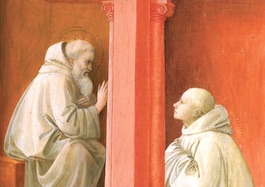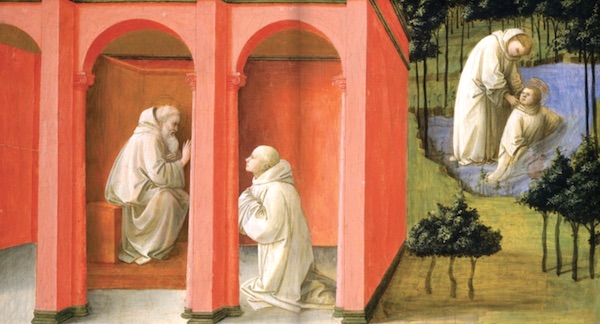Saint Benedict Orders Saint Maurus to the Rescue of Saint Placidus
- JEM SULLIVAN
Miracles wrought through the intercession of saints give evidence of their holiness and Christian virtue.
 Saint Benedict Orders Saint Maurus to the
Saint Benedict Orders Saint Maurus to the Rescue of Saint Placidus (c. 1445–1450)
National Gallery of Art, Washington, D.C.
by Fra Filippo Lippi (c. 1406–1469)
They confirm that the saint is so closely conformed to Jesus that he or she is able to work miraculous signs, in imitation of the miracles of Jesus during his public ministry.
Much of what is known about Saint Benedict, whose feast is celebrated on the eleventh day of July, comes from the second book of the Dialogues of Pope Gregory the Great, whose reign spanned the tumultuous late 6th and early 7th centuries. A Benedictine monk before his election to the papacy, Gregory had a deep love of monastic life and spirituality. To convey the intensity of Benedict's holiness and life of virtue, the pope recounted several miracles in his Dialogues. One of those miracles attributed to Saint Benedict is depicted in this predella painting (that is, forming the bottom of an altarpiece) by the Florentine artist Fra Filippo Lippi. Thought to have once been part of the main altarpiece of the Church of San Bernardo in Arezzo, the mid-15th century panel was removed from the altar and remained in an adjacent Olivetan monastery until 1767 or later. A miracle wrought by Saint Benedict is presented in vivid detail and color as a "visual catechesis" inviting our contemplation and imitation of the virtues of humility and obedience to God.
A school of the Lord's service
As he begins the second book of his Dialogues, Pope Gregory tells of Saint Benedict's journey from solitary life in a cave in Subiaco to his ministry as abbot and founder of monasteries. Having fled the corruption and self-indulgent decadence of Rome as a youth, Benedict by his holiness attracted large numbers of those who aspired to live a life of prayer and work in a "school of the Lord's service." And so it was that Benedict left the solitude of the cave to begin founding monasteries. Pope Gregory records that foundational moment when Benedict set up the original group of twelve monasteries with twelve monks and a few superiors in each.
The Rule of Saint Benedict laid the foundations of monastic life while inspiring the evangelization of Europe and the subsequent flowering of Christian faith and culture in medieval civilization.
Benedict, whose name means "blessed," would write a Rule that guided the eventual widespread flourishing of Western monasticism. The Rule of Saint Benedict laid the foundations of monastic life while inspiring the evangelization of Europe and the subsequent flowering of Christian faith and culture in medieval civilization.
Pope Gregory goes on to describe a practice common after the first monasteries were founded: noble and devout Christians from Rome would bring their sons to monasteries to be educated and formed in a life of prayer and work, embodied in the monastic axiom Ora et Labora. From this tradition come the figures in this dramatic painting.
Saint Maurus was the son of Equitius, a Roman nobleman who placed his child under the care of Benedict. Later on, Benedict would choose Maurus to assist in the governance of the monastery, as the young boy had grown into an outstanding model of monastic life, especially in the virtue of obedience. Similarly, Saint Placid, son of the Roman senator Tertullus, was brought as a young child by his father to the monastery to be educated and formed in faith under the care of the abbot Benedict.

Miracles do happen
One day, while the abbot Benedict was seated in his cell, young Placidus went to the nearby lake to draw water. While lowering his jug into the stream, he fell into strong currents that began to carry him away. From his cell, Saint Benedict sensed that the youth was in danger. So Benedict called the monk Maurus, whom we see kneeling before his abbot Benedict, shown seated in his red-colored cell on the left side of the painting. The artist captures the moment when Benedict, hand raised in a gesture of urgent command, sends Maurus to the rescue of Placidus.
Faith in God is a form of obedience, a word that barely resonates with positive connotation today.
In obedience, Maurus hurried to the lake to carry out his assigned task. Thinking he was still on dry land, he began to move miraculously over the water to rescue the drowning boy. Then, taking Placidus by the hair, the monk Maurus drew him out of the raging waters to safety. It is this dramatic moment of rescue that is captured on theright side of the composition. Only on returning to the lake shore did Maurus realize, in astonishment and wonder, that he had walked on the water!
Pope Gregory's account goes on to highlight the saintly virtues that he wished for his readers to contemplate and imitate. For on his return to Saint Benedict, Maurus related what had happened through the abbot's spiritual intuition and intercession. In humility, Benedict insists that it was the virtue of obedience on Maurus' part that wrought the miracle, and not Benedict's own merits. In turn, Maurus insisted that it was the abbot Benedict's inspired knowledge and command, and not his own virtue, that made the miracle possible. Placidus, whose life had been saved, resolved their holy dispute when he confirmed that at the very moment he was drawn out of the raging waters he felt Saint Benedict's cloak over his head and imagined that the holy man of God had drawn him out of danger to safety.
Faith as obedience to God
Faith in God is a form of obedience, a word that barely resonates with positive connotation today. From the Latin ob-audire, which means to "hear" or "listen to," the obedience of faith is the free submission of intellect and will to God's word, which is worthy of trust because it is guaranteed by God himself. The first word in the Rule of Saint Benedict is precisely ob-audire, that is, listen! Lippi's work here reminds us how in this miracle of Saint Benedict, and the spiritual discipline of monastic life he gifted to the Church, we can learn to grow in obedient listening to God alone, whose word of love and mercy rescues us from every raging stream in this world.
❧
 This is Meaghen Gonzalez, Editor of CERC. I hope you appreciated this piece. We curate these articles especially for believers like you.
This is Meaghen Gonzalez, Editor of CERC. I hope you appreciated this piece. We curate these articles especially for believers like you.
Please show your appreciation by making a $3 donation. CERC is entirely reader supported.

Acknowledgement
 Jem Sullivan. "Saint Benedict Orders Saint Maurus to the Rescue of Saint Placidus." Magnificat (July, 2020).
Jem Sullivan. "Saint Benedict Orders Saint Maurus to the Rescue of Saint Placidus." Magnificat (July, 2020).
Reprinted with permission of Magnificat.
Imags: Courtesy National Gallery of Art, Washington.
The Author
 Jem Sullivan is on the Pontifical Faculty of the Immaculate Conception at the Dominican House of Studies in Washington D.C. She teaches courses on Catholic Education: Teaching and Learning, the Documents of Vatican II, and Christian Art and the New Evangelization. She is the author of Study Guide to the United States Catholic Catechism for Adults and The Beauty of Faith.
Jem Sullivan is on the Pontifical Faculty of the Immaculate Conception at the Dominican House of Studies in Washington D.C. She teaches courses on Catholic Education: Teaching and Learning, the Documents of Vatican II, and Christian Art and the New Evangelization. She is the author of Study Guide to the United States Catholic Catechism for Adults and The Beauty of Faith.




